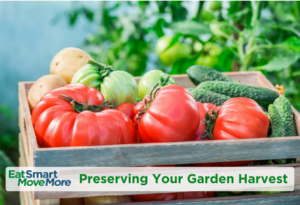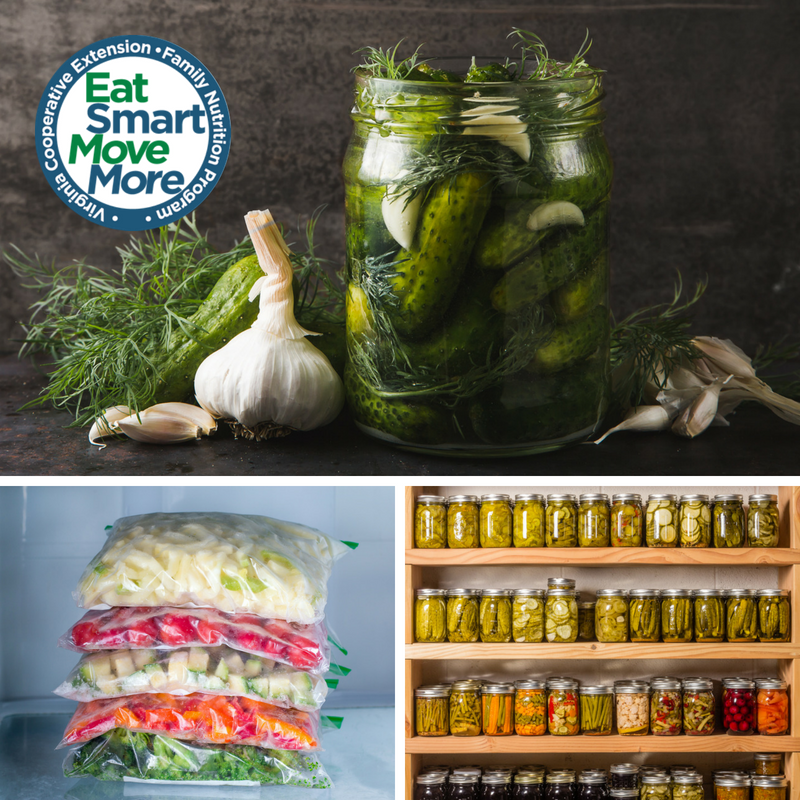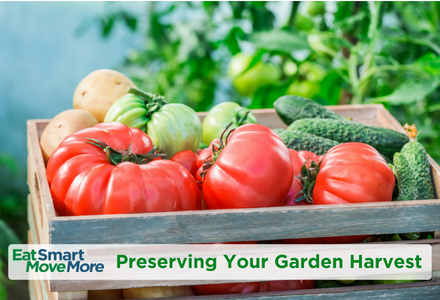 Gardens are in full bloom around the state. You might be overflowing with some fruits and veggies, like squash, zucchini, tomatoes, berries, or cucumbers. For many gardeners, there’s more produce than you can eat before it goes bad. There are several ways to preserve food to enjoy later, some take more effort than others. And even if you don’t garden yourself, you can still put up produce from the farmers market to enjoy over the winter. Many farmers offer discounts for bulk quantities or “seconds” (slightly blemished or misshapen, but still perfectly edible). This is just an overview of some different home food preservation techniques. Talk to your local extension office for expert advice on safe canning and pickling.
Gardens are in full bloom around the state. You might be overflowing with some fruits and veggies, like squash, zucchini, tomatoes, berries, or cucumbers. For many gardeners, there’s more produce than you can eat before it goes bad. There are several ways to preserve food to enjoy later, some take more effort than others. And even if you don’t garden yourself, you can still put up produce from the farmers market to enjoy over the winter. Many farmers offer discounts for bulk quantities or “seconds” (slightly blemished or misshapen, but still perfectly edible). This is just an overview of some different home food preservation techniques. Talk to your local extension office for expert advice on safe canning and pickling.
Freezing
Freezing is my favorite method of preserving food, provided you have the freezer space to store everything. It’s usually much easier and quicker than canning. Thoroughly wash the produce, peel, pit, and/or chop, and freeze. You can use freezer bags, freezer paper, or freezer-safe containers to package your produce. Some vegetables need to be blanched before freezing for best quality. Blanching requires quickly dropping veggies into boiling water for a short time (usually a minute) then dropping into an ice bath to stop the cooking process. This keeps veggies bright and crisp. I have frozen berries, pitted cherries, sliced plums, sliced peaches, whole tomatoes, diced onions, and diced peppers before. There is some prep work involved in washing and processing, but (depending on how much you’re working on), it’s not too overwhelming to do in an hour or two and enjoy for meals later. Bonus, since you’ve already prepped them, you can use in recipes with no extra work! Read more about freezing and find directions for freezing specific fruits and veggies on the National Center for Home Food Preservation website.
Canning
Like many people from Southwest Virginia, my grandmother canned A LOT of different foods she grew in her huge garden each year. She kept a whole cellar full of canned fruits and veggies to eat throughout the year, no refrigeration required. Because of better food availability in grocery stores year round and the amount of work and potential food safety issues, canning has fallen out of favor for most families. But some families never stopped canning and a new generation of gardeners and foodies is renewing interest in this preservation technique. There are two types of canning, water bath canning for high acid foods and pressure canning for low acid foods. If you want to try canning, be sure to get advice from a reputable source and follow approved recipes to prevent spoilage and botulism, a potentially fatal foodborne illness. These canning resources from the National Center for Home Food Preservation are a good starting point, but I highly recommend consulting with your local extension office (or an experienced canner) for canning safely.
Pickling and Fermenting
Pickling or fermenting is another food preservation method that is getting more popular beyond standard cucumber pickles. Pickled and fermented foods have a characteristic tang and fermented foods provide lots of healthy probiotics for good gut health. As with canning, careful attention must be paid to prevent foodborne illnesses and spoilage, so use approved recipes and consult with reputable sources before taking up fermenting.

What questions do you have about home food preservation? Share in the comments and I’ll be sure to get them answered! If you have any experience with freezing, canning, pickling, or fermenting, we’d love to hear from you! What is your favorite method? Is the prep work worth it to you? Do you recruit any help?

